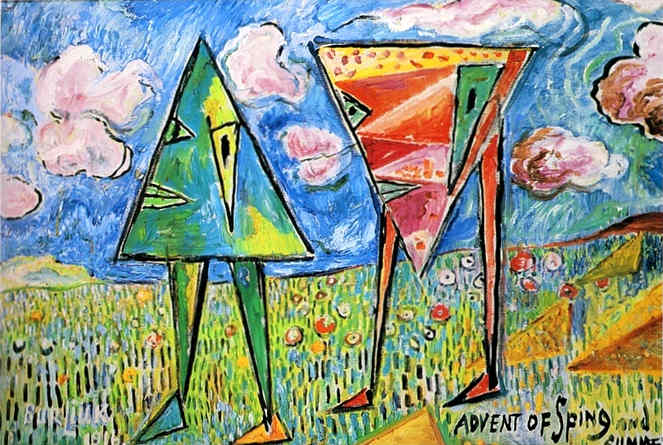David Burliuk is an extremely prolific artist, his work capacity caused not only respect, but also wonder among his contemporaries. Thousands of his works (no one can name the exact number of his works) are scattered all over the world, many have disappeared. As Burliuk’s influence spread beyond Eastern Europe, almost all of these early works moved toward museums instead of the private market. Which undoubtedly makes his art worthwhile enough to buy antique paintings of his. For an excellent antique painting price and to this day, you can buy his work of extraordinary antique valuations.
Burliuk styled himself as "the father of Russian futurism". Like most artists of the beginning of the 20th century, Burlyuk oscillated between different styles moving from realism to Picasso's cubism, Monet's impressionism and Derain's Fauvism. So, his artworks can be met among antique paintings for sale, often featuring very different topics - landscapes, animals, and futuristic impressions of people and nature. And there are plenty of opportunities, not just for people who like to buy antique oil paintings.
(1).jpg)
David Davidovich Burliuk in 1914. Source: commons.wikimedia
David Burliuk believed that the art born of the spirit of free artists should not limit itself to any one school or narrow aesthetic path. And this completely coincides with his life and creative position. He changed manners and styles, while remaining a deeply individual and bright artist. His creative path is divided into the three main periods, each is characterized by its own style, the special subtext and semiotics: the beginning of the 20th century - 1920 - Ukraine and Russia; 1920 - 1922 - Japan; 1922 - 1967 United States of America.
Early Burlyuk was not yet imbued with the militant spirit of futurism, his work is characterized by the features of impressionism, his paintings breathe the harmony and beauty of nature ("On the veranda", 1907).
His artworks are full of symbols. The mythopoetic system of the Ukrainian people is dominant in his work. It is characterized by a combination of Christianity with ancient pagan sources. Burlyuk's series of graphic works on Scythian themes (illustrations for the book "The Garden of Judges II". St. Petersburg, 1913) shows a clear interest in petroglyphs and ancient ornamentation. The names of the paintings: "Danaid Barrel", "Temple of Janus" (both 1917), "Daughters of Zeus" (undated) indicate this involvement.
In his myth-making, Burlyuk turns to the folk image of the Cossack Mamai, the kobzar, the "people's saint" ("Cossack Mamai", 1908). It can be assumed that "Cossack Mamai" is a spiritual self-portrait of the artist. The self-perception of the artist is connected with belonging to the Cossack lineage.
The paintings " Svyatoslav еру Prince " (1915), "Cossack Mamai" (1908) and "Carousel" (1921) are key to understanding the figurative structure of Burliuk's mythopoetics. These works complement each other, the artist created archetypes characteristic of mythological consciousness.
.jpg)
David Burliuk. A horse-lightning.1907. Source: wikiart
In Burlyuk's art, the“wild”, “freedom-loving”, "extremely tired" horse plays an important symbolic role ("Lightning Horse", 1907; "Horses", 1910). "Lightning horse" is one of Burlyuk's first full-fledged futuristic paintings in which the idea of "futurism as a movement" - found visual reflection. Futurism was perceived by David Burlyuk - from his own confession - as a new worldview, as a new era that destroys old familiar forms: "Futurism is a free judgment about nature - nature taken in the moments of its movement."

David Burliuk. "Advent of Sping". 1914. Source: commons.wikimedia
Cover image: David Burliuk. "Cossack Mamay". 1912. Source: commons.wikimedia


